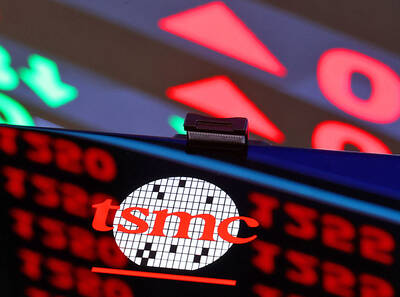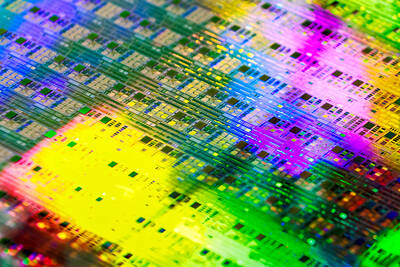The US economy is likely to keep deteriorating early this year — after shrinking last quarter by the most since 1982 — as consumers and businesses retrench.
The 3.8 percent annual pace of contraction in the fourth quarter was less than forecast, with a buildup of unsold goods cushioning the blow. Excluding inventories, the decline was 5.1 percent, the Commerce Department said on Friday in Washington.
Job cuts announced last month by companies from Starbucks Corp and Pep Boys Manny, Moe & Jack to Eastman Kodak Co mean there’ll be little respite in the first half of this year, economists said.
“The recession is going to last through most of 2009 and we’ll be lucky to have growth back at zero by the end of the year,” Kenneth Rogoff, a Harvard University economics professor, said in an interview from Davos, Switzerland, on Friday. Economic growth “will be pretty tepid for a long time.”
US stocks fell yesterday, capping the market’s worst January as more companies reported disappointing earnings. The Standard & Poor’s 500 Stock Index decreased 2.3 percent to close at 825.88. Treasuries advanced, sending benchmark 10-year note yields to 2.84 percent from 2.86 percent late on Thursday.
Friday’s report underscored the hit to households from the biggest wealth destruction on record. Consumer spending, which accounts for about 70 percent of the economy, dropped 3.5 percent following a 3.8 percent fall the previous three months. It’s the first time decreases exceeded 3 percent back-to-back since records began in 1947.
The Institute for Supply Management-Chicago said on Friday its business barometer decreased to 33.3 from 35.1 the prior month. The index has remained below 50, the dividing line for contraction, for four months. Meanwhile, consumer confidence rose less than forecast this month, a Reuters/University of Michigan index showed. The gauge climbed to 61.2 from 60.1 in December.
A separate report showed that employment costs in the US rose at the slowest pace in almost a decade in the fourth quarter as companies limited wage gains and benefits. The Labor Department’s employment-cost index rose 0.5 percent.
“Without the stimulus plan, the economy would be flat to declining in the second half of the year,” said Laurence Meyer, vice chairman of Macroeconomic Advisers LLC in Washington and a former Federal Reserve governor.
With the recovery package, the unemployment rate may peak at 8 percent instead of 9.5 percent or higher, he added.
The world’s largest economy shrank at a 0.5 percent annual rate from July through September. The back-to-back contraction is the first since 1991.
Economists at Morgan Stanley and Deutsche Bank Securities Inc in New York lowered their forecasts for growth in the first three months of this year following the report. They both now estimate the economy’s worst drop will occur this quarter.
For all of last year, the economy expanded 1.3 percent as a boost from exports and government tax rebates in the first half of the year helped offset the deepening spending slump.
The GDP price gauge dropped at a 0.1 percent annual pace in the fourth quarter, the most since 1954, reflecting the slump in commodity prices. The Fed’s preferred measure, linked to consumer spending and excluding food and fuel, rose at a 0.6 percent pace, the least since 1962.
Unadjusted for inflation, GDP shrank at a 4.1 percent pace, the most since the first three months of 1958. The drop in so-called nominal growth explains why corporate profits slumped as the year ended.
“This is a severe, steep, broadly based recession” with “no quick fix,” Stephen Roach, chairman of Morgan Stanley Asia Ltd, said on Friday.
Americans could pull back further as employers slash payrolls. Companies cut 524,000 workers in December, bringing total job cuts for last year to almost 2.6 million. The unemployment rate in December was 7.2 percent, up from 4.9 percent a year before.
The economic slump intensified last quarter as companies also retrenched. Business investment dropped at a 19 percent pace, the most since 1975. Purchases of equipment and software dropped at a 28 percent pace, the most in half a century.
The slump in home construction also accelerated, contracting at a 24 percent pace last quarter after a 16 percent drop in the previous three months.

SEMICONDUCTOR SERVICES: A company executive said that Taiwanese firms must think about how to participate in global supply chains and lift their competitiveness Taiwan Semiconductor Manufacturing Co (TSMC, 台積電) yesterday said it expects to launch its first multifunctional service center in Pingtung County in the middle of 2027, in a bid to foster a resilient high-tech facility construction ecosystem. TSMC broached the idea of creating a center two or three years ago when it started building new manufacturing capacity in the US and Japan, the company said. The center, dubbed an “ecosystem park,” would assist local manufacturing facility construction partners to upgrade their capabilities and secure more deals from other global chipmakers such as Intel Corp, Micron Technology Inc and Infineon Technologies AG, TSMC said. It

People walk past advertising for a Syensqo chip at the Semicon Taiwan exhibition in Taipei yesterday.

NO BREAKTHROUGH? More substantial ‘deliverables,’ such as tariff reductions, would likely be saved for a meeting between Trump and Xi later this year, a trade expert said China launched two probes targeting the US semiconductor sector on Saturday ahead of talks between the two nations in Spain this week on trade, national security and the ownership of social media platform TikTok. China’s Ministry of Commerce announced an anti-dumping investigation into certain analog integrated circuits (ICs) imported from the US. The investigation is to target some commodity interface ICs and gate driver ICs, which are commonly made by US companies such as Texas Instruments Inc and ON Semiconductor Corp. The ministry also announced an anti-discrimination probe into US measures against China’s chip sector. US measures such as export curbs and tariffs

The US on Friday penalized two Chinese firms that acquired US chipmaking equipment for China’s top chipmaker, Semiconductor Manufacturing International Corp (SMIC, 中芯國際), including them among 32 entities that were added to the US Department of Commerce’s restricted trade list, a US government posting showed. Twenty-three of the 32 are in China. GMC Semiconductor Technology (Wuxi) Co (吉姆西半導體科技) and Jicun Semiconductor Technology (Shanghai) Co (吉存半導體科技) were placed on the list, formally known as the Entity List, for acquiring equipment for SMIC Northern Integrated Circuit Manufacturing (Beijing) Corp (中芯北方積體電路) and Semiconductor Manufacturing International (Beijing) Corp (中芯北京), the US Federal Register posting said. The